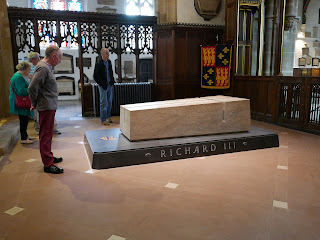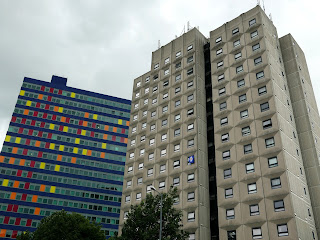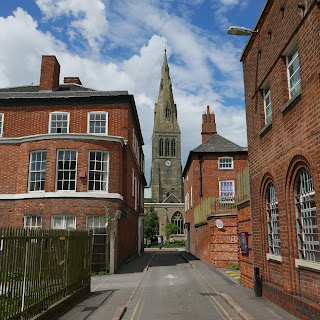Richard III (1452-1485) has always been painted as a villain, an ambitious opportunist on the Yorkist side in the Wars of the Roses - a fifteenth-century Northern civil war that dragged on for years. He has always been put down as an unscrupulous man, devious and cunning. And as the suspected murderer of his brother's children, after denying them any inheritance rights. They were kept prisoner in the Tower of London and eventually disappeared from public view, never to be seen again. Conclusions were drawn.
And there was another thing about him: a sinister deformity. Richard was always referred to - at least from the time of Shakespeare onwards - as a hunchback, a misshapen character lurching onto the Elizabethan stage - and indeed onto later stages in later times - bitter in the knowledge of his unattractiveness, and the dreadful deeds he had done in the name of naked ambition. The antithesis of what a king should ideally be. A man of black heart who overreached himself, and, deserted and horseless, was mercilessly struck down in battle on Bosworth Field in Leicestershire.
Of course, one shouldn't rely on Shakespeare for true history! More modern scholarship - now immensely aided by the discovery of his remains, so that his DNA can be analysed, and his skeleton 3D-printed and forensically examined - has discovered a different man. Still not a man to warm to, still a man driven, and ruthless; but not the irredeemable arch-villain shaped like a crouching Quasimodo that Shakespeare decided to portray. He really did have a spinal deformity, but not one that anyone would necessarily have noticed once he was clothed, or in his armour. But more on that in a moment.
I set forth from Stamford station, an architectural gem much in keeping with the rest of the town:
This part of the East Midlands has been something of a find. It is very 'Cotswold' in feel, and you get the same kind of attractive stone buildings everywhere. Stamford is perfect for an evening's walkabout, although on this visit the heavens opened and I had to shelter while a thunderstorm rolled by, pounding the streets with rain, but leaving a nice rainbow in its wake. Even in the rain, the old town looked good:
It was a smooth 40-minute train ride to Leicester's modern, spacious station:
The return fare - using my Senior Railcard - was a reasonable £8.90. I like train journeys when on holiday, making them part of the holiday experience, and this was the first of three.
My first objective was some kind of lunch. I began to walk along Granby Street, which I imagine was once one of the important traffic routes into the centre. It's quieter now, with a decidedly edge-of-town feel about it. There were however an extraordinary number of specialised shops for men. If you wanted a sharp suit for a fashionable wedding, and an even sharper haircut to go with it, then this was the street, even if the local taste in these things seemed, well, very unSussex. But there were of course more familiar offerings, among them a Wetherspoons pub called The Last Plantagenet - clearly alluding to Richard III himself. I settled on that. Why not save myself some cash? And indeed I got a baguette lunch, and a gin-and-tonic to go with it, for just £5.25. Mind you, I wondered whether I'd made a wise choice. The pub did have women and children inside, but you mainly heard the raucous laughter of men who had had too much cheap beer. But hey-ho.
Further along, I saw an odd-looking building called the Turkey Café. It was clearly on the tourist trail, and a board nearby explained all about it. (Leicester was full of helpful information boards, explaining to visitors what they were looking at) Some kind of special gathering was taking place at street level: it looked like a wedding reception. I recognised the type of men's suit and haircut.
I was soon looking for signs to the Richard III exhibition. I found however that Leicester has a confusing layout and it's easy to lose your sense of direction. Despite apparently adequate signing, such as this:
But eventually I found myself near my goal. It was further away than I'd thought. On the way I got a distant glimpse of the University Area, at the end of this avenue of trees. (There were students everywhere)
Close to the Richard III Exhibition Building was this board on the gates of what looked like a disused brewery:
It said that after recovery from the battlefield, Richard's body was put on public display and then left in the hands of the Greyfriars Friary, whose people popped him into a modest grave. Over the centuries that followed, the precise whereabouts of the grave was forgotten. It was eventually rediscovered when the car park on the Friary site was dug up.
Round the corner was the building I was seeking. The entrance seemed rather modest. It's the low-level construction in the lower left of the shot below.
Admission with an age concession was £7.00. Hmm. More than my lunch had cost! And this wasn't, say, a grandiose stately home. But it was what I'd come to see, so I coughed up and went inside. All visitors were urged to watch a fairly lengthy video presentation, involving actors telling different parts of the Richard III story.
It seemed to be some sort of Shakespearean pastiche in contemporary costume. I gave it two minutes then moved on. Other rooms beckoned. These gave the visitor a flavour of the period through sound, visual effects, and things to touch. I soon skipped all that. I wanted to see the proper exhibits, dealing with the body found in the car park, and what was done with it. Upstairs I found what I really wanted to see. The skeleton had indeed been carefully scanned and DNA-analysed to make sure that it really was Richard III's; also what had actually been 'wrong' with him; precisely how he had died on the battlefield; and how he might have looked while living. There was besides this a resumé of past literary references to him, revealing how his memory had become denigrated in English history.
This is the 3D-print of his skeleton, the original having been reburied in the nearby Cathedral:
The spinal curvature was pronounced, but it was a lateral curvature, and he would not have been bent over like someone with typical osteoporosis. His naked back might well have looked odd, but clothed he would have seemed completely normal. He died when still only thirty-two, and up till then would have coped perfectly well with an active life. But the spinal curvature would have crowded his lungs, increasingly restricting his ability to take deep breaths. It would also of course have made him lose a little height. Still, in his armour he would have remained an imposing figure:
The hole in the top of the skull indicated a penetrating wound from a pointed weapon like a spear or pike, thrust with great force. Richard would have been bent forward, perhaps on his knees, helmet off, presumably already wounded. Death would have been instant, the brain skewered.
The University of Dundee had reconstructed his face:
This was their final result:
It wasn't far removed from the paintings of him, all made long after he died, but apparently based on contemporary sketches. Here is one such posthumous painting:
The modern reconstruction makes him look commanding and imperious. The paintings - perhaps with an eye to political correctness in the subsequent no-nonsense Tudor era - suggest craftiness and cunning, and are not sympathetic at all.
That wasn't quite all there was to see. They had preserved the actual grave site in situ, and I went downstairs again to have a look. It was almost like a modern chapel. You had to stand on a wide sheet of plate glass and look down. I was used to such things.
That was still not quite the end of my Richard III tour. I next went to see his modern (2014) tombstone in the Cathedral.
Wow. Fit for a king. Plain and simple - but a very strong, dignified design.
I had about fifty minutes to make my way back to the station. I decided to buy some inexpensive sunglasses from New Look. I had to ask the way, but that was no problem. I saw Leicester's various shopping centres. The city is full of shops. And it's full of fine buildings. Here's a selection:
There's an area called The Lanes. It's a joined-up collection of back yards really, and not like the narrow alleyways in The Lanes of Brighton - but attractive for all that:
There's also a vast modern shopping mall called High Cross:
There's even a huge traditional central Market, with an imposing Corn Exchange building:
Thomas Cook, the tour holiday organiser, was one of Leicester's sons, and has his own statue by the station:
He looks a bit stern and impatient to me. Perhaps he's fed up waiting to check in his luggage.
And what about Leicester's people? They were everywhere! And believe me, most diverse. I can fully believe that Leicester is a successful 'melting pot' city, where all ethnic groups jostle along very nicely and enjoy the amenities of their very friendly city to the full. I caught this picture, but would never use it to make a negative point about the ethnic mix:
It was typically much more like this:
Time to wind up. I really enjoyed my visit to Leicester. Once I had got its basic geography fixed in my mind, it seemed a pleasant, happening sort of place with room for everybody. I considered lingering for an evening meal, but my will to tramp the streets for another hour or two had evaporated, and I was glad to quit and get back to the peaceful comforts of my caravan near Stamford. I had always thought that Midland cities must be dull. Clearly not so. Next time I'll have a look at Nottingham.


























































